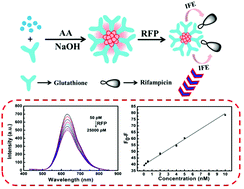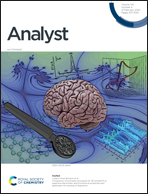An ultra-sensitive “turn-off” fluorescent sensor for the trace detection of rifampicin based on glutathione-stabilized copper nanoclusters†
Abstract
Rifampicin is a common antibiotic used in human and veterinary medicine to treat tuberculosis and other diseases caused by numerous pathogenic bacteria. However, the excessive or improper use of rifampicin usually leads to a series of problems, including bacterial resistance, excessive drug-resistance and water pollution. Thus, it is of great importance to develop selective and sensitive assays for monitoring rifampicin in biological systems. In this study, we designed a fluorescence “turn-off” strategy for the trace detection of rifampicin based on a glutathione-stabilized copper nanoclusters (GSH-Cu NC) sensor. In an aqueous solution, the fluorescence of the GSH-Cu NCs at 632 nm can be quenched effectively and selectively by rifampicin due to the inner-filter effect (IFE) of fluorescence mechanism. Distinctively, this GSH-Cu NC sensor exhibited excellent fluorescence sensing capability for the trace detection of rifampicin with a very low limit of detection (LOD) of 16 pM in a wide linear range from 50 to 10 000 pM. It is not only more sensitive than the other methods previously reported for the detection of rifampicin, but also has an outstanding selectivity and strong anti-interference in complex samples. Furthermore, the as-developed GSH-Cu NCs were also successfully applied to determine rifampicin in different real samples with quantitative spike recoveries ranging from 97% to 105%.



 Please wait while we load your content...
Please wait while we load your content...